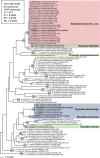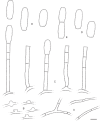Taxonomy and phylogeny of the Erysiphe lonicerae complex (Helotiales, Erysiphaceae) on Lonicera spp
- PMID: 34124617
- PMCID: PMC8165964
- DOI: 10.3114/fuse.2021.07.03
Taxonomy and phylogeny of the Erysiphe lonicerae complex (Helotiales, Erysiphaceae) on Lonicera spp
Abstract
The phylogeny and taxonomy of powdery mildews, belonging to the genus Erysiphe, on Lonicera species throughout the world are examined and discussed. Phylogenetic analyses revealed that sequences retrieved from Erysiphe lonicerae, a widespread powdery mildew species distributed in the Northern Hemisphere on a wide range of Lonicera spp., constitutes a complex of two separate species, viz., E. lonicerae (s. str.) and Erysiphe ehrenbergii comb. nov. Erysiphe lonicerae occurs on Lonicera spp. belonging to Lonicera subgen. Lonicera (= subgen. Caprifolium and subgen. Periclymenum), as well as L. japonica. Erysiphe ehrenbergii comb. nov. occurs on Lonicera spp. of Lonicera subgen. Chamaecerasus. Phylogenetic and morphological analyses have also revealed that Microsphaera caprifoliacearum (≡ Erysiphe caprifoliacearum) should be reduced to synonymy with E. lonicerae (s. str.). Additionally, Erysiphe lonicerina sp. nov. on Lonicera japonica in Japan is described and the new name Erysiphe flexibilis, based on Microsphaera lonicerae var. flexuosa, is introduced. The phylogeny of Erysiphe ehrenbergii and E. lonicerae as well as other Erysiphe species on honeysuckle is discussed, and a survey of all species, including a key to the species concerned, is provided. Citation: Bradshaw M, Braun U, Götz M, Takamatsu S (2020). Taxonomy and phylogeny of the Erysiphe lonicerae complex (Helotiales, Erysiphaceae) on Lonicera spp. Fungal Systematics and Evolution 7: 49-65. doi: 10.3114/fuse.2021.07.03.
Keywords: Ascomycota; E. flexibilis; E. lonicerina; Erysiphe ehrenbergii; Lonicera; epitypification; new taxa; powdery mildew; systematics.
© 2021 Westerdijk Fungal Biodiversity Institute.
Figures



Similar articles
-
Erysiphe lonicerigena sp. nov., a Powdery Mildew Species Found on Lonicera harae.Mycobiology. 2023 Apr 13;51(2):67-71. doi: 10.1080/12298093.2023.2182952. eCollection 2023. Mycobiology. 2023. PMID: 37122682 Free PMC article.
-
Phylogeny and taxonomy of powdery mildew caused by Erysiphe species on Lupinus hosts.Mycologia. 2022 Jan-Feb;114(1):76-88. doi: 10.1080/00275514.2021.1973287. Epub 2021 Dec 1. Mycologia. 2022. PMID: 34851235
-
Phylogeny and taxonomy of the genera of Erysiphaceae, part 5: Erysiphe (the "Microsphaera lineage" part 1).Mycologia. 2024 Jan-Feb;116(1):106-147. doi: 10.1080/00275514.2023.2252715. Epub 2024 Jan 19. Mycologia. 2024. PMID: 37955985
-
Grapevine powdery mildew (Erysiphe necator): a fascinating system for the study of the biology, ecology and epidemiology of an obligate biotroph.Mol Plant Pathol. 2012 Jan;13(1):1-16. doi: 10.1111/j.1364-3703.2011.00728.x. Epub 2011 Jun 20. Mol Plant Pathol. 2012. PMID: 21726395 Free PMC article. Review.
-
Sequencing Herbarium Specimens of a Common Detrimental Plant Disease (Powdery Mildew).Phytopathology. 2020 Jul;110(7):1248-1254. doi: 10.1094/PHYTO-04-20-0139-PER. Epub 2020 Jun 3. Phytopathology. 2020. PMID: 32407253 Review.
Cited by
-
Reduction of flavonoid content in honeysuckle via Erysiphe lonicerae-mediated inhibition of three essential genes in flavonoid biosynthesis pathways.Front Plant Sci. 2024 Apr 16;15:1381368. doi: 10.3389/fpls.2024.1381368. eCollection 2024. Front Plant Sci. 2024. PMID: 38689843 Free PMC article.
-
What are the 100 most cited fungal genera?Stud Mycol. 2024 Jul;108:1-411. doi: 10.3114/sim.2024.108.01. Epub 2024 Jul 15. Stud Mycol. 2024. PMID: 39100921 Free PMC article.
-
Erysiphe lonicerigena sp. nov., a Powdery Mildew Species Found on Lonicera harae.Mycobiology. 2023 Apr 13;51(2):67-71. doi: 10.1080/12298093.2023.2182952. eCollection 2023. Mycobiology. 2023. PMID: 37122682 Free PMC article.
-
Discover hidden taxa of Erysiphe section Erysiphe fungi (Ascomycota, Erysiphaceae) based on morphology and multilocus phylogeny in China.MycoKeys. 2025 Jun 4;118:119-146. doi: 10.3897/mycokeys.118.154217. eCollection 2025. MycoKeys. 2025. PMID: 40510759 Free PMC article.
References
-
- Alfieri SA, Jr, Langdon KR, Wehlburg C, et al. . (1984). Index of Plant Diseases in Florida (Revised). Florida Department of Agriculture and Consumer Services Division of Plant Industry, Bulletin 11: 1–389.
-
- Amano (Hirata) K. (1986). Host Range and Geographical Distribution of the Powdery Mildew Fungi. Japan Scientific Societies Press, Tokyo.
-
- Anonymous (1960). Index of Plant Diseases in the United States. [U.S.D.A. Agriculture Handbook 165.]. Washington.
-
- Blumer S. (1933). Die Erysiphaceen Mitteleuropas unter besonderer Berücksichtigung der Schweiz. Beiträge zur Kryptogamenflora der Schweiz 7: 1–483.
-
- Blumer S. (1967). Echte Mehltaupilze (Erysiphaceae). G. Fischer Verlag, Jena.
LinkOut - more resources
Full Text Sources
Other Literature Sources
Miscellaneous
